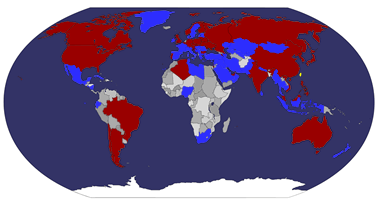L'anniversaire du Grand Chef, le Camarade Kim Jong Il


Four stamps were issued to celebrate the birthday of Leader Kim Jong Il.
The stamps show some of gift plants the overseas sompatriots and foreign figures who ardently revere Lerder Kim Jong Il presented to him.
3 won stamp: Crinum bracteaturm
Herbs perennial , rarely shrubby or treelike, often with bulbs, corms, rhizomes, or tubers. Leaves basal or cauline, often narrow, margin entire or spiny . Inflorescence a terminal spike, umbel, raceme , panicle, or flowers solitary. Flowers bisexual , actinomorphic or zygomorphic, usually subtended by 1 to several spathaceous involucres. Perianth segments 6, in 2 whorls, free or connate to form a short tube , with or without a corona . Stamens 6, inserted at perianth throat or at base of segments; filaments sometimes basally connate; anther dorsifixed or basifixed , mostly introrse . Ovary inferior, 3-loculed; ovules few to many per locule; placentation axile . Style slender; stigma capitate or 3-lobed. Fruit a capsule, usually loculicidal, sometimes dehiscing irregularly, rarely a berry. Seeds with endosperm.
12 won stamp: Begonia cu. Irene Nuss
Begonias are tender perennials, grown for their colorful flowers and foliage. Most begonias can be grown outdoors in pots, in the ground, or in hanging baskets in filtered light and moist, but well drained soil. Where not hardy, grow as annuals or indoors as houseplants. Most begonias can be propagated from leaf, stem or rhizome cuttings in addition to being sown from seed. 'Irene Nuss' has many dark pink, fragrant, pendulous flowers and lobed, ovate, wavy, leaves that have green and red coloration. The stem is cane-like with evenly spaced nodes. This plant enjoys filtered light but can take some sun in winter. Soil should ideally be moist. Begonias grow very well in peat-based compost also.
120 won stamp: Callistemon phoeniceus
Callistemon phoeniceus (Lesser Bottlebrush) is a shrub or small tree in the family Myrtaceae. It is endemic to Western Australia. It grows up to between 1 and 6 metres in height. Red flower spikes are produced between September and January in the species native range. It occurs on sandy soils, often beside streams.
The species was first formally described in 1839 by botanist John Lindley in A Sketch of the Vegetation of the Swan River Colony as Callistemon phoeniceum, which was later revised to Callistemon phoeniceus. In his 2006 paper New Combinations in Melaleuca for Australian Species of Callistemon (Myrtaceae), Lyndley Craven, a research botanist from the Australian National Herbarium proposed that this species should be renamed as Melaleuca phoenicea.
160 won stamp: Plumeria rubra
Plumeria rubra is a deciduous plant belonging to the genus Plumeria. Its common names are Red Frangipani, Common Frangipani, Temple Tree, or simply Plumeria. Originally native to Mexico, Central America, Colombia and Venezuela, it has been widely cultivated in subtropical and tropical climates worldwide and is a popular garden and park plant, as well as being used in temples and cemeteries. It grows as a spreading tree to 7-8 m (20-25 ft) high and wide, and is flushed with fragrant flowers of shades of pink, white and yellow over the summer and autumn.

































 taiwan
taiwan  cover or postcard
cover or postcard  FDC
FDC 






























































































No comments:
Post a Comment